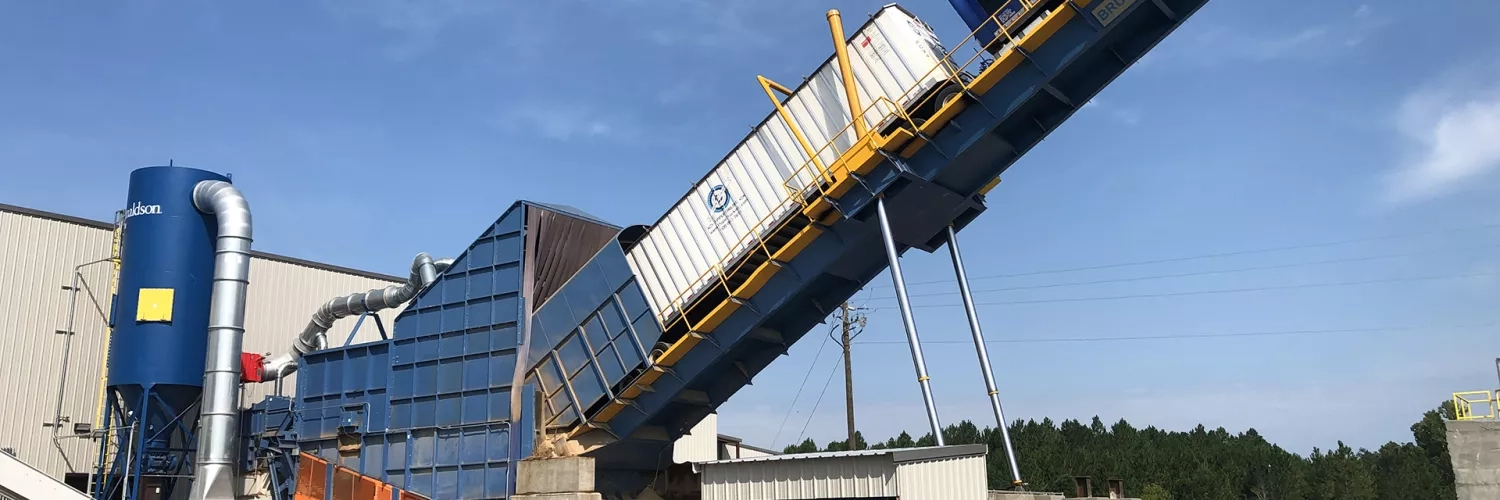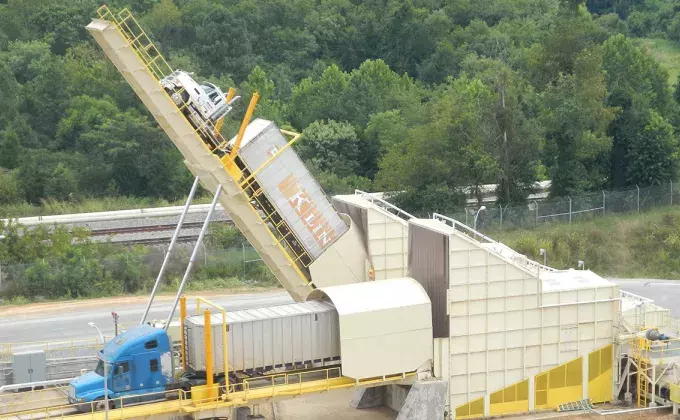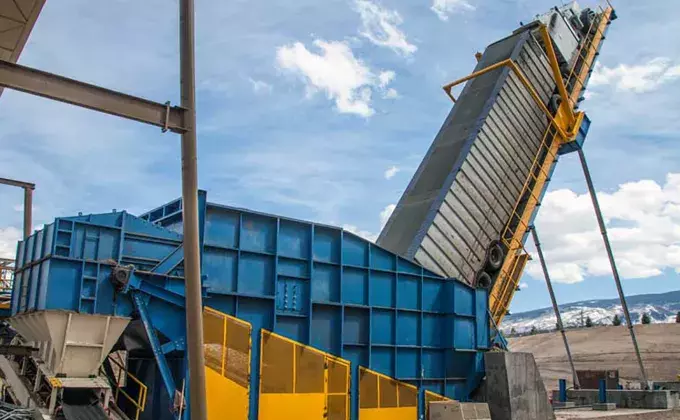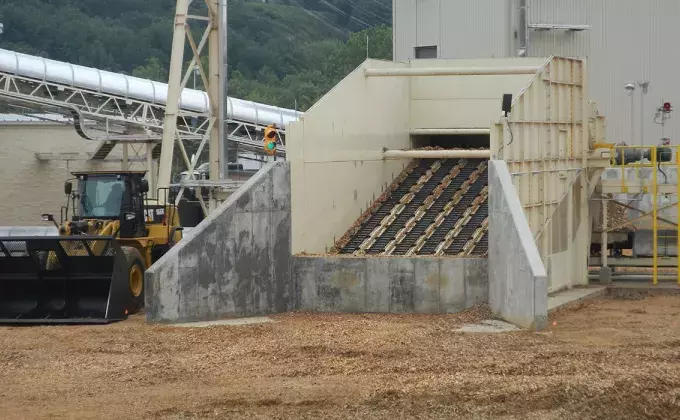Unique truck unloading capabilities ensures efficiency of onward processing
Bulk trucks are a flexible and effective way to distribute and receive the huge volumes of processed wood and other free-flowing organic material required by the bioenergy, and the pulp and paper, and particleboard industries. The efficiency of bulk truck loading and unloading can dictate production capacity.
To support the unloading of these specialist trucks, where a receiving facility can process hundreds of trucks a day, Bruks Siwertell has developed a unique truck unloading equipment portfolio that focuses on the fastest, most efficient way to discharge both end-dumping and self-unloading trucks, so that onward processing is as effective as possible.
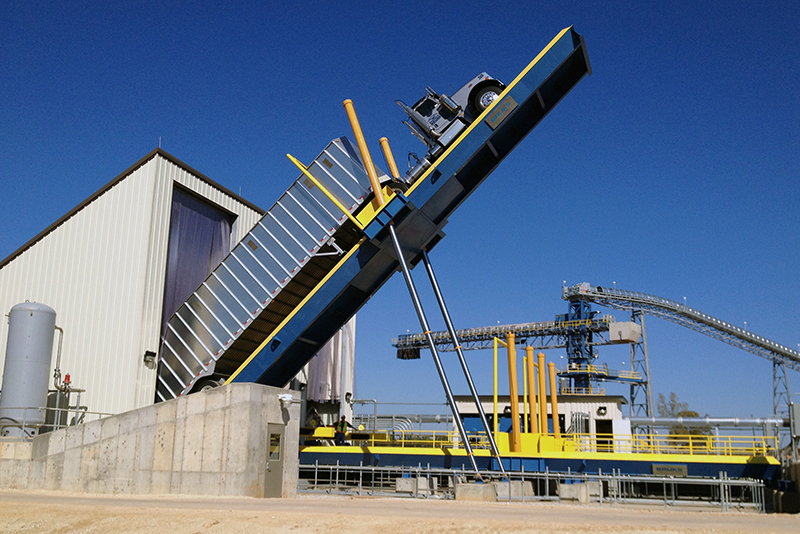
END-DUMPING TRUCKS RAISED WITH EASE
The majority of bulk trucks in North America are end-dumping, requiring unique truck unloading machinery to raise the truck and load so that material free-falls from the end of the trailer. Bruks Siwertell offers three main versions of truck unloading equipment: back-on, drive-over, and extended arm type truck dumpers.
Back-on truck dumpers are much as the name describes, drivers back their trailers onto the platform where raised tire guides keep them positioned as the cab reverses. Average times between trucks is usually less than ten minutes including backing on, lifting and lowering the load, closing the back doors, and then driving off the platform. They can be paired with our Bruks receiving hopper.
Drive-over truck dumpers allow for trucks to be driven straight onto the tipping platform in a forward position, crossing a pit bridge. The average time between trucks is eight to nine minutes, making this process slightly faster as the driver does not need to reverse a trailer into place. These can also be paired with our Bruks receiving hopper.
Extended arm truck dumpers enable the rapid unloading of free-flowing dry bulk material into a receiving hopper, which is tilted and positioned above ground. This minimizes civil engineering costs by reducing overall truck ramp requirements. The extended tipper arm allows material to fall from the trailer into the angled hopper. With the trailer dumping at this raised elevation, material cannot build up inside the trailer, potentially increasing cycle times. This enhances truck unloading efficiency and maintains an optimum truck-processing capacity.
All Bruks Siwertell’s truck tipping platforms deliver long-term, cost-effective operations and have been designed to reliably perform under very high-use conditions, offering an expected service life of two million tipping and lowering cycles, which exceeds 25 years of full-time operation.
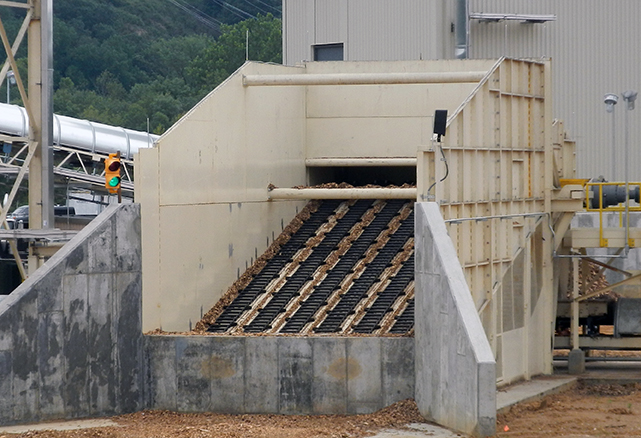
MITIGATING DUST EMISSIONS FROM TRUCK UNLOADING OPERATIONS
Controlling dust emissions from handling dry materials is an important and growing concern at many facilities. While materials such as wet wood chips and barky fuels are not particularly dusty, dry sawdust, planer shavings, pellets and many agricultural materials are very dusty, and can easily be problematic if left unchecked and uncontained.
In addition to very efficient unloading cycles, the popularity of our truck unloading technology is based on its ability to minimize dust emissions to negligible levels.
The basic design of the truck dumper has been optimized to reduce dust emissions. Primarily, dust is controlled by our low-profile end-pivot design, which ensures that the truck unloads its cargo at a low elevation, approximately 2.5m above the ground, and directly into the back end of the hopper. This keeps the impact of the material very low and results in minimal dust emissions, particularly when handling very dry materials such as wood shavings or wood pellets.
In most cases, the low-profile design and a covered hopper is sufficient protection against dust emissions. Where facilities are located close to other industries or populated areas, the truck dumper can be covered with a fixed or rotating hood. Both versions mitigate dust emissions by bridging the gap between the truck dump end and the covered hopper.
The fixed version is fitted onto the end of the hydraulic lifting platform. The rotating hood is fitted both to the platform and the hopper and articulates when the platform is raised and lowered.
Where no dust emissions are permitted, a dust collector can also be specified. Dust collectors can be mounted directly over the covered hopper, or ducted to a central baghouse so that the customer can make better use of it.
Self-unloading trucks supported by specialized hoppers
Whatever the truck type, we have the truck unloading system to support it; including self-unloading. These are more widely used in Europe and come in a variety of forms. Versions tip material out from the side and some use ‘walking floors’ to effectively push material out of the back of the trailer.
Worldwide, self-unloading trucks benefit from our range of Bruks receiving hoppers, including in-ground versions and variations of these, which are perfectly matched to suit the high efficiency profile of this truck type.
 Bruks-Siwertell
Bruks-Siwertell
